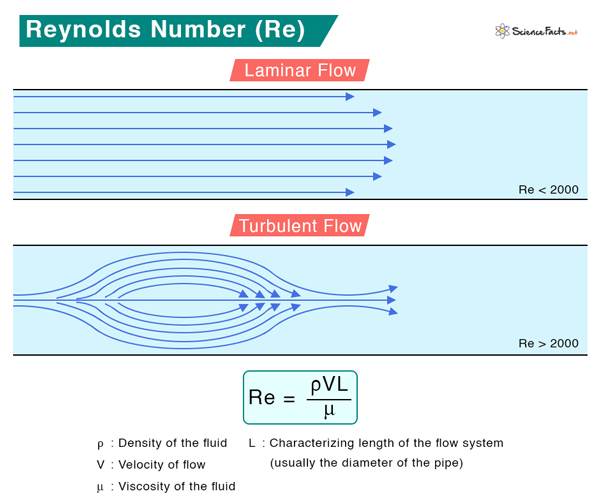Reynolds Number
Reynolds number is a term associated with fluid mechanics that predicts the pattern in which fluid flows under different situations. In other words, it determines whether a fluid flow is laminar or turbulent. The flow is laminar at a low Reynolds number, and at a high Reynolds number, the flow is turbulent. Reynolds number is widely applied to study liquid flow in pipes and airflow over aircraft’s wings.
Reynolds number is named after British physicists Osborne Reynolds, who popularized its use in 1883.
Equation
Reynolds number is a dimensionless quantity. It is the ratio between the inertial and viscous forces of the fluid.
Where
ρ is the density of the fluid
V is the velocity of the flow
L is the characterizing length in the flow system (usually the diameter of the pipe)
μ is the viscosity of the fluid
The number helps to categorize laminar flow from turbulent flow of any fluid like air or water. Laminar flow refers to the smooth and steady flow. It is also known as streamline flow. On the other hand, turbulent flow is irregular and chaotic due to the fluid’s changing velocity. If Re < 2000, the flow is laminar. If Re > 2000, the flow is turbulent.
Unit and Dimension
Reynolds number is a dimensionless quantity and does not have any unit. We can prove it by taking the division of inertial force and viscous force dimensions.
Critical Reynolds Number
The critical Reynolds number determines the transition from laminar to turbulent flow for a particular fluid system as the flow rate increases. It is a limit where the laminar flow changes to turbulent flow. If the calculated Reynolds number is greater than the critical Reynolds number, the flow regime is turbulent; otherwise, the flow regime is laminar. For a Newtonian fluid, a value of 2100 is taken as the critical Reynolds number.
Example Problems and Solutions
Problem 1: Determine the fluid flow with a relative density of 80 kg/m3, a viscosity of 0.7 Nˑs/m2, and a velocity of 6 m/s through a pipe of 0.25 m diameter.
Solution
Given
ρ = 80 kgˑm-3 V = 6 mˑs-1 L = 0.25 m μ = 0.7 Nˑsˑm-2 = 0.7 kgˑmˑs-2ˑsˑm-2 = 0.7 kgˑm-1ˑs-1
The Reynolds Number is
Re = ρVL/μ
=> Re = (80 kgˑm-3 x 6 mˑs-1 x 0.25 m)/0.7 kgˑm-1ˑs-1
=> Re = 120 kgˑm-1ˑs-1ˑ/0.7 kgˑm-1ˑs-1
=> Re = 171
Since Re < 2000, the flow is Laminar.
-
References
Article was last reviewed on Friday, July 28, 2023








